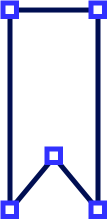Late in April the NFDI4ING community working in research software engineering met to discuss current developments, give feedback on NFDI4ING services, and had the opportunity to make new contacts and network. About 40 people participated in the interactive online “Community Meeting” format.
Hosted by Betty
The archetype ‘Betty’, which in NFDI4ING stands for engineers who develop research software as self-taught programmers, symbolically acted as host and linked the contributions from various engineering disciplines. There was a varied programme with different interactive formats. After a welcome by the hosts, Bernd Flemisch (University of Stuttgart, Task Area Betty) and Jan Linxweiler (TU Braunschweig, Community Cluster Construction Engineering & Architecture), Jörg Unger (Federal Institute for Materials Research and Testing) moderated the first session.
Workshop on Benachmarking
In a workshop format, the participants collaborated on the topic of ‘benchmarking’ and explored the question of how researchers can use benchmarks to compare and improve the performance of their simulation software workflows and what requirements there are for benchmarking.
Showcases – Betty’s research engine & ROkit
The second session comprised two showcases: Vasiliy Seibert (TU Clausthal) began by presenting the NFDI4ING service, ‘Betty’s Research Engine’, before inviting participants to discuss the features that an AI-based assistance component in the search engine should have. How about being able to chat with Betty in future to tackle and refine your searches? The input from the community provides valuable feedback for the further development of Betty’s Research Engine.
Andreas Noback (TU Darmstadt) then gave an interesting insight into ‘ROkit’, a modular, extensible software framework. It connects the NFDI4ING ingest service for research data on built cultural heritage with a disciplinary ROkit RDF store. The presentation was aimed in particular, but not exclusively, at researchers in construction engineering and architecture who work with digital methods and digitised and 3D-generated building objects.
SHOWME.how
The third session was reserved for a contribution from the community: Alan Correa, V Mithlesh Kumar, Anil Yildiz and Julia Kowalski (all from RWTH Aachen University) had applied for a community contribution. Alan Correa, representing his team, presented the SHOWME.how approach, a method that supports researchers in orchestrating the quantity and diversity of computational workflow components. The subsequent discussion showed that the approach was of great interest. The participants encouraged the authors to continue pursuing their approach and to present it at the CoRDI or NFDI4ING conference in autumn 2025.
Regular NFDI4ING community meetings
The ‘Community Meeting’ – this time symbolically hosted by ‘Betty’ – once again proved to be an effective format for not only introducing researchers to the diverse NFDI4ING services and for providing space for feedback, networking and community solutions. The Community Meetings take place roughly every two months and focus on varying engineering research areas, with each of the NFDI4ING archetypes acting as host in turn.
Jan Linxweiler (TU Braunschweig), 0000-0002-2755-5087
Bernd Flemisch (Universität Stuttgart), 0000-0001-8188-620X
Katja Wermbter (TU Braunschweig), 0000-0002-7593-6968
